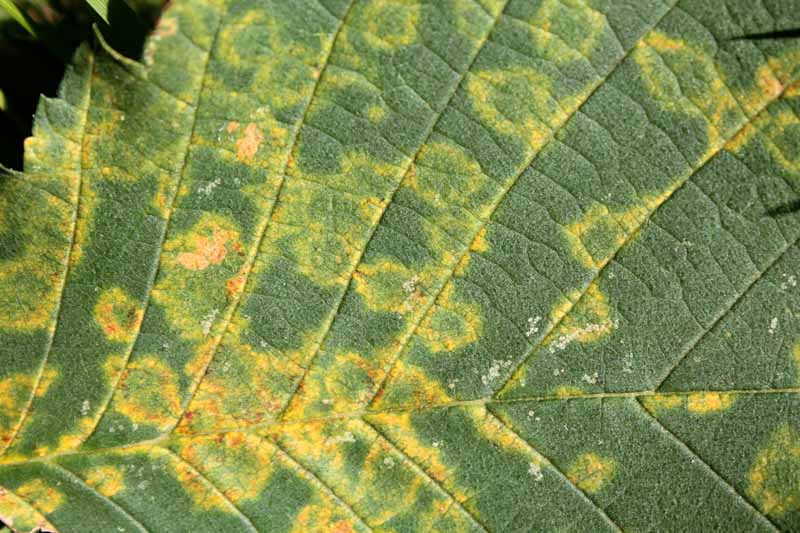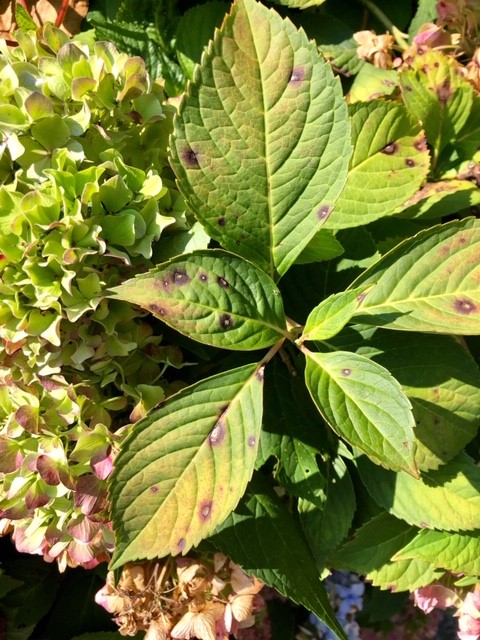Hydrangea yellow spots on leaves may be caused by a variety of factors, including fungal diseases, nutrient deficiencies, or environmental stressors. It is important to identify the specific cause in order to effectively treat and prevent further damage to the plant.
In this blog post, we will explore the common causes of yellow spots on hydrangea leaves and provide tips on how to address each issue. By understanding the underlying causes and implementing proper care practices, you can help your hydrangeas thrive and maintain their vibrant foliage.
So, let’s dive in and find out what might be causing those yellow spots on your hydrangea leaves.

Credit: gardenerspath.com
Introduction To Hydrangea Health
Introduction to Hydrangea Health:
Hydrangeas are known for their stunning beauty and vibrant colors. These popular garden plants are cherished for their large, showy blooms that come in various shades of pink, blue, and white. However, maintaining the health of hydrangeas is crucial to ensure their beauty lasts.
The Beauty of Hydrangeas:
Hydrangeas are beloved for their ability to transform any garden into a picturesque landscape. Their voluminous clusters of flowers create a stunning visual impact that is hard to ignore. Whether used as standalone plants or in floral arrangements, hydrangeas never fail to impress with their sheer elegance.
Common Signs of Foliage Distress:
When it comes to hydrangea health, it is important to be aware of common signs of foliage distress. One such sign is the presence of yellow spots on the leaves. These spots can indicate nutrient deficiencies, diseases, or pest infestations. It is essential to address these issues promptly to prevent further damage and maintain the overall health of the plant.

Credit: www.wilsonbrosgardens.com
Identifying Yellow Spots
Yellow spots on hydrangea leaves can be a sign of various issues. These spots may be irregular in shape and range in color from light yellow to dark brown. They can also appear as small, circular lesions.
Characteristics of these spots can include a yellow halo around the edges or a stippled appearance.
Potential causes of yellow spots on hydrangea leaves include fungal diseases such as Cercospora leaf spot and bacterial infections like bacterial leaf spot.
Environmental factors like nutrient deficiencies, overwatering, and physical damage can also lead to the development of yellow spots. It’s important to carefully examine the leaves and consider the overall health of the plant when identifying and addressing the issue.
Assessing Environmental Factors
Sunlight Exposure: Hydrangeas require direct sunlight for at least 5-6 hours per day to thrive. Ensure they are planted in an area with morning sun and afternoon shade to prevent leaf burn.
Soil Conditions: Hydrangeas prefer moist, well-draining soil with a slightly acidic pH level between 5.2 and 6.5. Amend the soil with organic matter to improve its drainage and fertility. Avoid waterlogged or compacted soil to prevent root rot.

Credit: plantaddicts.com
Watering Practices
Proper hydration techniques are crucial in preventing yellow spots on hydrangea leaves. Overwatering can lead to root rot, which in turn can cause yellow spots on leaves. To avoid overwatering, make sure the soil is well-draining and only water when the top inch of soil feels dry.
Underwatering can also cause yellow spots on leaves. To prevent this, water deeply and thoroughly once or twice a week. It’s important to note that different hydrangea varieties have different water requirements, so be sure to research the specific needs of your plant.
| Signs of Overwatering | Signs of Underwatering |
|---|---|
| – Yellowing leaves | – Wilting leaves |
| – Root rot | – Dry soil |
| – Mold or fungus growth | – Leaf drop |
Nutrient Management
To manage yellow spots on hydrangea leaves, proper nutrient management is essential. Ensure the plant receives adequate nutrients such as nitrogen, potassium, and iron to maintain healthy foliage. Regular soil testing can help determine any deficiencies and guide the application of the necessary nutrients for optimal growth.
| Essential Nutrients for Hydrangeas | |
|---|---|
| Nutrient | Role |
| Nitrogen | Stimulates growth and enhances leaf and stem production |
| Phosphorus | Encourages root development and flower formation |
| Potassium | Helps with water uptake and improves overall plant health |
Hydrangea yellow spots on leaves can be an indication of nutrient imbalances. It is important to ensure that your hydrangeas are receiving the essential nutrients they need to thrive. Nitrogen stimulates growth and enhances leaf and stem production, while phosphorus encourages root development and flower formation.
Potassium helps with water uptake and improves overall plant health. Correcting nutrient imbalances can be done through fertilization or amending the soil. It is important to carefully follow the recommended application rates and frequency for your specific hydrangea variety.
Disease Prevention And Control
Hydrangeas are susceptible to various diseases that can cause yellow spots on their leaves. The most common diseases affecting hydrangeas are powdery mildew, leaf spot, and rust.
To prevent these diseases, it is important to maintain good hygiene practices such as regularly removing dead leaves and debris from around the plant. Avoid overhead watering and ensure proper spacing between plants for adequate air circulation.
Common Hydrangea Diseases
| Disease | Symptoms | Treatment |
|---|---|---|
| Powdery Mildew | White or gray powdery coating on leaves | Apply fungicide and prune infected areas |
| Leaf Spot | Brown or black spots on leaves | Remove infected leaves and apply fungicide |
| Rust | Orange or brown spots on leaves | Remove infected leaves and apply fungicide |
Treatment Options
If yellow spots on hydrangea leaves are already present, it is important to identify the disease and treat it promptly. Fungicides and pruning infected areas are effective treatments for most hydrangea diseases. Additionally, maintaining proper hygiene practices and providing adequate nutrition and water can help prevent disease outbreaks.
Pest Intrusion And Remedies
Hydrangeas are a popular flowering shrub that can be affected by yellow spots on their leaves. These spots can be caused by pests such as spider mites, aphids, and whiteflies. Identifying these harmful pests is crucial to controlling their impact on the plant.
Spider mites are tiny and hard to see, but their webs are a telltale sign of their presence. Aphids are small, pear-shaped insects that often cluster on new growth. Whiteflies are small, moth-like insects that fly around the plant when disturbed.
Organic control measures include spraying the plant with neem oil or insecticidal soap, or introducing beneficial insects like ladybugs. Chemical control measures include using pesticides, but these should be used as a last resort and with caution to avoid harm to beneficial insects and the environment.
| Organic Control Measures | Chemical Control Measures |
|---|---|
| -Spray with neem oil | -Use pesticides as a last resort |
| -Spray with insecticidal soap | -Use with caution to avoid harm to beneficial insects and the environment |
| -Introduce beneficial insects like ladybugs |
Cultural Practices For Healthy Hydrangeas
When it comes to cultural practices for healthy hydrangeas, it’s important to pay attention to pruning techniques. Proper pruning can help maintain the plant’s shape and encourage new growth.
Additionally, seasonal care tips are essential for keeping hydrangeas healthy throughout the year. It’s important to water the plants regularly and provide adequate sunlight. Moreover, applying a layer of mulch can help retain moisture and regulate the soil temperature.
In addition, fertilizing hydrangeas in the spring can promote strong, healthy growth. By following these cultural practices, you can ensure that your hydrangeas thrive and remain vibrant.
Advanced Care Strategies
When dealing with hydrangea yellow spots on leaves, advanced care strategies are essential for addressing the issue effectively. Foliar feeding can help deliver essential nutrients directly to the plant, promoting overall health and vitality.
Additionally, adjusting the soil pH can play a crucial role in ensuring optimal nutrient uptake and minimizing stress on the plant. By implementing these advanced care strategies, you can support your hydrangeas in maintaining vibrant, healthy foliage.
Recovery And Maintenance
Recovery and maintenance are crucial for resolving hydrangea yellow spots on leaves. Monitoring plant recovery is an important step in ensuring long-term health. Regularly check the leaves for any signs of improvement or deterioration.
Look for any changes in color, size, or texture. Adjust watering and fertilization practices accordingly. Provide adequate sunlight and proper drainage to promote healthy growth.
Remove any damaged or infected leaves to prevent further spread of the problem. Consider implementing a long-term health plan to maintain the overall well-being of the plant. This may include regular pruning, mulching, and pest control measures.
By consistently monitoring and caring for your hydrangeas, you can help them recover from yellow spots and thrive.
Frequently Asked Questions
Why Do My Hydrangea Leaves Have Yellow Spots?
Yellow spots on hydrangea leaves are often a sign of a fungal infection called leaf spot. This is caused by excessive moisture on the leaves, poor air circulation, or overwatering. To prevent this, ensure proper watering, provide good airflow, and remove any infected leaves.
How Do You Treat Spots On Hydrangea Leaves?
To treat spots on hydrangea leaves, remove infected leaves and clean up any fallen debris. Avoid overhead watering and provide good air circulation. Apply a fungicide labeled for hydrangeas, following the instructions carefully. Monitor the plant regularly for any signs of new spots and take appropriate action.
What Does Overwatered Hydrangea Look Like?
An overwatered hydrangea appears wilted, with yellowing leaves and potential root rot. The soil may feel consistently moist, causing stunted growth and a lack of blooms. Adjust watering habits to prevent overwatering and ensure proper drainage for a healthy hydrangea.
How Do You Treat Yellow Spots On Plants?
To treat yellow spots on plants, identify the cause and take appropriate action. It could be due to overwatering, nutrient deficiency, pests, or disease. Adjust watering, provide proper nutrition, and use organic pest control methods. If the problem persists, consult a professional for further guidance.
Conclusion
To wrap up, if you notice yellow spots on your hydrangea leaves, it is crucial to take immediate action. By identifying the underlying causes, such as nutrient deficiencies, pests, or diseases, you can effectively treat and prevent further damage. Remember to maintain proper watering, provide adequate sunlight, and regularly inspect your plants for any signs of distress.
With proper care and attention, your hydrangeas will thrive and display vibrant, healthy leaves. Stay vigilant and proactive to ensure the longevity and beauty of your hydrangea plants.
- 25 Low Light Pet-Safe Indoor Plants: Safe for Pets & Perfect for Low Light! - September 18, 2024
- 15 Best Indoor Plants for Beginners: Care Tips & Guide - September 17, 2024
- 32 Best Indoor Plants for Air Purification Safe for Pets - September 16, 2024
